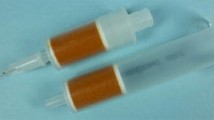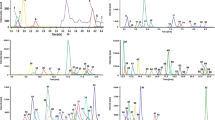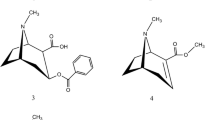Abstract
In the context of driving ability diagnostics in Germany, administrative cutoffs for various drugs and pharmaceuticals in urine have been established. Two liquid chromatography–tandem mass spectrometry methods for simultaneous detection and quantification of amphetamines, designer amphetamines, benzoylecgonine, benzodiazepines, opiates, and opioids in urine were developed and validated. A 500-μL aliquot of urine was diluted and fortified with an internal standard solution. After enzymatic cleavage, online extraction was performed by an ion-exchange/reversed-phase turbulent flow column. Separation was achieved by using a reversed-phase column and gradient elution. For detection, a Thermo Fisher TSQ Quantum Ultra Accurate Mass tandem mass spectrometer with positive electrospray ionization was used, and the analytes were measured in multiple-reaction monitoring mode detecting two transitions per precursor ion. The total run time for both methods was about 15 min. Validation was performed according to the guidelines of the Society of Toxicological and Forensic Chemistry. The results of matrix effect determination were between 78 % and 116 %. The limits of detection and quantification for all drugs, except zopiclone, were less than10 ng/mL and less than 25 ng/mL, respectively. Calibration curves ranged from 25 to 200 ng/mL for amphetamines, designer amphetamines, and benzoylecgonine, from 25 to 250 ng/mL for benzodiazepines, from 12.5 to 100 ng/mL for morphine, codeine, and dihydrocodeine, and from 5 to 50 ng/mL for buprenorphine and norbuprenorphine. Intraday and interday precision values were lower than 15 %, and bias values within ± 15 % were achieved. Turbulent flow chromatography needs no laborious sample preparation, so the workup is less time-consuming compared with gas chromatography–mass spectrometry methods. The methods are suitable for quantification of multiple analytes at the cutoff concentrations required for driving ability diagnostics in Germany.


Similar content being viewed by others
References
Ojaniemi KK, Lintonen TP, Impinen AO, Lillsunde PM, Ostamo AI (2009) Accid Anal Prev 41:191–196
Drummer OH, Gerostamoulos J, Batziris H, Chu M, Caplehorn J, Robertson MD, Swann P (2004) Accid Anal Prev 36:239–248
Dams R, Murphy CM, Lambert WE, Huestis MA (2003) Rapid Commun Mass Spectrom 17:1665–1670
Schubert W, Mattern R (2009) Urteilsbildung in der Medizinisch-Psychologischen Fahreignungsdiagnostik. Kirschbaum Bonn
Agius R, Nadulski T, Moore C (2012) Forensic Sci Int 215:38–45
Kirschbaum KM, Musshoff F, Wilbert A, Rohrich J, Madea B (2011) Forensic Sci Int 207:66–69
Mueller DM, Duretz B, Espourteille FA, Rentsch KM (2011) Anal Bioanal Chem 400:89–100
Ynddal L, Hansen SH (2003) J Chromatogr A 1020:59–67
Breaud AR, Harlan R, Di Bussolo JM, McMillin GA, Clarke W (2010) Clin Chim Acta 411:825–832
Sauvage FL, Gaulier JM, Lachatre G, Marquet P (2006) Ther Drug Monit 28:123–130
Peters FT, Paul LD, Musshoff F, Aebi B, Auwaerter V, Kraemer T, Skopp G (2009) Toxichem Krimtech 76:185–208. https://www.gtfch.org/cms/files/GTFCh_Richtlinie_Anhang%20B_Validierung_Version%201.pdf
Alnouti Y, Srinivasan K, Waddell D, Bi H, Kavetskaia O, Gusev AI (2005) J Chromatogr A 1080:99–106
DIN 32645 (2012) https://www.beuth.de/de/norm/din-32645/110729574
Matuszewski BK, Constanzer ML, Chavez-Eng CM (2003) Anal Chem 75:3019–3030
Concheiro M, de Castro CA, Quintela O, Cruz A, Lopez-Rivadulla M (2007) J Anal Toxicol 31:573–580
Ming DS, Heathcote J (2011) J Chromatogr B Anal Technol Biomed Life Sci 879:421–428
Kacinko SL, Concheiro-Guisan M, Shakleya DM, Huestis MA (2008) Anal Bioanal Chem 392:903–911
Acknowledgments
The authors thank H.H. Maurer, Dietmar Bregel, and all the staff members of the Institute of Legal Medicine in Homburg for their support and help during the method development.
Author information
Authors and Affiliations
Corresponding author
Rights and permissions
About this article
Cite this article
Schaefer, N., Peters, B., Schmidt, P. et al. Development and validation of two LC-MS/MS methods for the detection and quantification of amphetamines, designer amphetamines, benzoylecgonine, benzodiazepines, opiates, and opioids in urine using turbulent flow chromatography. Anal Bioanal Chem 405, 247–258 (2013). https://doi.org/10.1007/s00216-012-6458-9
Received:
Revised:
Accepted:
Published:
Issue Date:
DOI: https://doi.org/10.1007/s00216-012-6458-9




